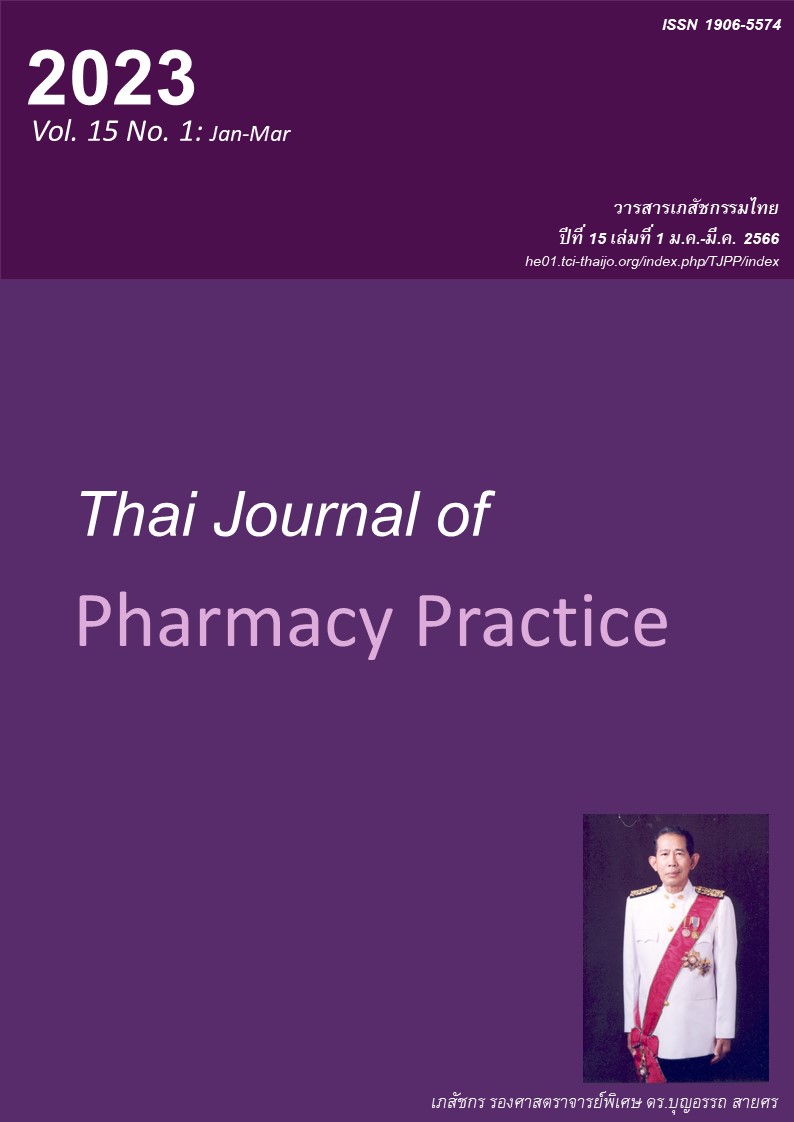การพัฒนาและประเมินผลโปรแกรมการจัดการความปวดโดยญาติซึ่งเป็นผู้ดูแลผู้ป่วยมะเร็งระยะท้าย
Main Article Content
บทคัดย่อ
วัตถุประสงค์: เพื่อพัฒนาและประเมินผลโปรแกรมการจัดการความปวดโดยญาติซึ่งเป็นผู้ดูแลผู้ป่วยมะเร็งระยะท้าย วิธีการ: งานวิจัยนี้เป็นงานวิจัยเชิงปฏิบัติการ ผู้ร่วมวิจัยประกอบด้วย 1) ทีมผู้ร่วมวิจัย ได้แก่ แพทย์ พยาบาล และเภสัชกร จำนวน 15 คน 2) ผู้รับบริการ ได้แก่ ญาติผู้ดูแล 19 คน และผู้ป่วย19 คนที่เป็นโรคมะเร็งท่อน้ำดี มะเร็งต่อมน้ำเหลือง และอื่น ๆ การศึกษาระยะที่ 1 เป็นการศึกษาสภาพการณ์ของคลินิกประคับประคองโดยรวบรวมข้อมูลจากการสังเกตและสัมภาษณ์ผู้ร่วมวิจัย การศึกษาระยะที่ 2 เป็นการพัฒนาโปรแกรมการจัดการความปวดโดยผู้ดูแล โดยการประชุมระดมสมองในกลุ่มผู้ร่วมวิจัย การศึกษาระยะที่ 3 เป็นการติดตามและประเมินผลลัพธ์ด้านพฤติกรรม/เจตคติของผู้ให้บริการด้านความปวดของผู้ป่วย ปัญหาที่เกิดจากการใช้ยา ความรู้เกี่ยวกับการจัดการความปวด การรับรู้สมรรถนะการจัดการความปวด และความพึงพอใจของญาติผู้ดูแล ผลการวิจัย: การศึกษาในระยะที่ 1 พบว่า คลินิกประคับประคองมีปัญหาด้านการปฏิบัติงานคือ ระบบการให้บริการ ความแตกต่างทางประสบการณ์ของผู้ปฏิบัติงาน ความพร้อมของยา สถานที่ และความเข้าใจของผู้ปฏิบัติงาน ปัญหาด้านผู้รับบริการ คือ ความพร้อมของผู้รับบริการ และทัศนคติต่อการใช้มอร์ฟีนและต่อผู้ให้บริการ การศึกษาระยะที่ 2 พบประเด็นที่ส่งผลต่อการพัฒนาโปรแกรมการจัดการความปวด 5 ประเด็น ได้แก่ 1) ผู้ปฏิบัติงานมีทัศนคติที่ดีต่อการดูแลแบบประคับประคอง 2) ผู้ปฏิบัติงานมีความรู้/ทักษะในการจัดการความปวด 3) การมี Kapanol® 4) การแยกพื้นที่ในการให้บริการ และ 5) การปรับปรุงแนวปฏิบัติและพัฒนาโปรแกรมฯ ทีมผู้ร่วมวิจัยกำหนดกิจกรรมที่ตอบสนองประเด็นที่ส่งผลต่อการพัฒนา การพัฒนาแบ่งเป็น 2 วงรอบ แต่ละวงรอบมี 4 ขั้นตอน คือวางแผน ปฏิบัติ สังเกต และสะท้อนผล การศึกษาระยะที่ 3 ประเมินผลของโปรแกรมการจัดการความปวด พบว่าทีมผู้ให้บริการมีความรู้/ความเข้าใจ มีทัศนคติที่ดีต่อการดูแลแบบประคับประคอง คะแนนความปวดปัจจุบันของผู้ป่วยลดลงอย่างมีนัยสำคัญทางสถิติ (P<0.05) คะแนนความปวดน้อยที่สุดใน 24 ชั่วโมงไม่แตกต่างกัน ปัญหาที่พบจากการใช้ยาลดลง ผู้ดูแลมีความรู้ในการจัดการความปวดเพิ่มขึ้น สมรรถนะแห่งตนในการจัดการความปวดเพิ่มขึ้น และความพึงพอใจอยู่ในระดับสูง สรุป: การนำกระบวนการวิจัยเชิงปฏิบัติการมาใช้ สามารถพัฒนาโปรแกรมการจัดการความปวดโดยผู้ดูแลสำหรับดูแลผู้ป่วยระยะท้ายที่เหมาะสมกับบริบทของโรงพยาบาลได้
Article Details

อนุญาตภายใต้เงื่อนไข Creative Commons Attribution-NonCommercial-NoDerivatives 4.0 International License.
ผลการวิจัยและความคิดเห็นที่ปรากฏในบทความถือเป็นความคิดเห็นและอยู่ในความรับผิดชอบของผู้นิพนธ์ มิใช่ความเห็นหรือความรับผิดชอบของกองบรรณาธิการ หรือคณะเภสัชศาสตร์ มหาวิทยาลัยสงขลานครินทร์ ทั้งนี้ไม่รวมความผิดพลาดอันเกิดจากการพิมพ์ บทความที่ได้รับการเผยแพร่โดยวารสารเภสัชกรรมไทยถือเป็นสิทธิ์ของวารสารฯ
เอกสารอ้างอิง
World Health Organization. Palliative care news fact sheets [online]. 2018 [cited Feb 19, 2018]. Available from: www.who.int/news-room/fact-sheets/detail/pal liative-care
Strategy and Planning Division. Twenty-year national strategic plan for public health [online]. 2019 [cited Nov 10, 2019]. Available from: dmsic.moph.go.th/in dex/detail/7602
van den Beuken-van Everdingen MH, de Rijke JM, Kessels AG, Schouten HC, van Kleef M, Patijn J. Prevalence of pain in patients with cancer: a systematic review of the past 40 years. Ann Oncol 2007; 18:1437-49.
Brennan F, Carr DB, Cousins M. Pain management: a fundamental human right. Anesth Analg 2007; 105: 205-21.
Gureje O, Von Korff M, Simon GE, Gater R. Persistent pain and well-being: a World Health Organization study in primary care. JAMA 1998; 280:147-51.
Deandrea S, Montanari M, Moja L, Apolone G. Prevalence of under-treatment in cancer pain. A review of published literature. Ann Oncol 2008; 9: 1985-91.
Sawasdeenarunat v., Taneerat A., Wisettharn T. The development of palliative care model for terminal cancer patients at Maharaj Nakhon Si Thammarat hospital. Nursing Journal of the Ministry of Public Health 2015; 25: 144-56.
Pacharapaisarn N. Hospital pharmacists’ knowledge and attitudes toward opioid medications for cancer pain management. FDA Journal 2018; 23: 63-74.
Kanchanachari O, Sirapo-ngam Y, Monkong S. Roles and needs of caregivers for patients with end of life in a specific setting for palliative care. Ramathibodi Nursing Journal 2018; 23: 328-43.
Meecharoen W. Family caregivers of cancer patients : roles’ adaptation and quality of life promotion. Ramathibodi Nursing Journal 2014; 20: 10-22.
Chi NC, Demiris G, Pike KC, Washington K, Oliver DP. Pain management concerns from the hospice family caregivers' perspective. Am J Hosp Palliat Care 2018; 35: 601-11.
Kutragun R, Namvongprom A. Pain management system development in patients with advanced cancer. Journal of Nursing and Health Care 2018; 36: 189-97.
Wimolphan P, Kamwan P. Effectiveness of nursing practice guidelines for pain management in gastrointestinal cancer patients. Nursing Journal 2014; 40: 85-96.
Semsarn S, Chaiviboontham S, Chansriwong P. Effects of family caregiver training program on family caregivers and patients outcomes in terminal care of chronic illness patients. Thai Journal of Nursing and Midwifery Practice 2018; 5: 112-26.
Kemmis S, McTaggart R. The action research planner. 3rd ed. Geelong: Deakin University; 1992.
Karunruk Palliative Care Center, Srinagarind Hospital Faculty of Medicine, Khon Kaen University. Handbook of palliative guidelines. Khonkan: Klung nana Vitthaya Press; 2018.
Macindo JRB, Soriano CAF, Gonzales HRM, Simbulan PJT, Torres GCS, Que JC. Development and psychometric appraisal of the Pain Manage ment Self-Efficacy Questionnaire. J Adv Nurs 2018; 74: 1993–2004.
Aoun S, Bird S, Kristjanson JL, Currow D. Reliability testing of the FAMCARE-2 scale: measuring family career satisfaction with palliative care. Palliat Med 2010; 24: 674-81.
Hanrinth R. Classification for drug related problems. Thai Journal of Pharmacy Practice 2009; 1: 84-96.
Bloom BS. Taxonomy of education. New York: David McKay; 1975.
Chukaew S, Sirapo-ngam Y, Prapaipanich W. Knowledge, attitude, and practice perceived by nurses in helping and promoting caregivers’ health. Ramathibodi Nursing Journal 2013; 18: 249-58.
Chuepan S. Development of care system for foot ulcer prevention in persons with diabetes. Thai Journal of Nursing and Midwifery Practice 2016; 3: 28-39.
Sakulpong K, Phokhwang-Just W, Gnamwongwiwat B. Development of community-based palliative care model for patients with cancer: A case study of Banpunruk Suratthani. Nursing Journal of the Ministry of Public Health 2018; 27: 90-103.
Loknimith W, Janda T. Self-perceived palliative care competencies of nurse working in a university hospital within less than two years of receiving bachelor’s degrees. Journal of Royal Thai Army Nurses 2020; 21: 373-81.
Khangsri D, Awipan R, Suwannaprom P. Participa tion of primary health care personnel in the develop ment process for drug dispensing and counseling services. Thai Journal of Pharmacy Practice 2013; 5: 92-107.
Silaruks B, Limwattananon C, Limwattananon S, Boonkaw P. Community participation in diabetes screening service: in the context of primary care unit. Thai Journal of Hospital Pharmacy 2008; 18: 52-62.


